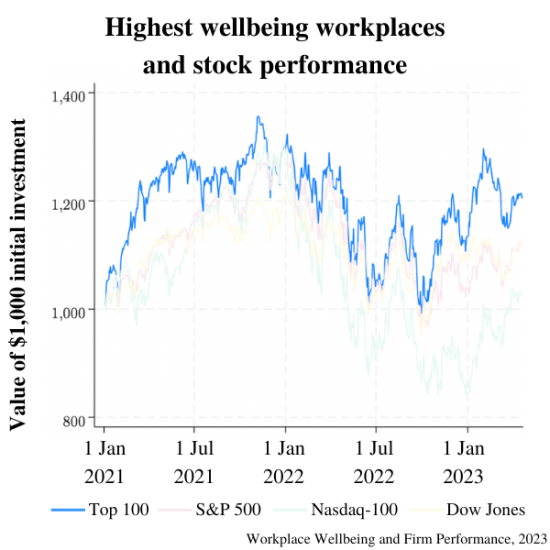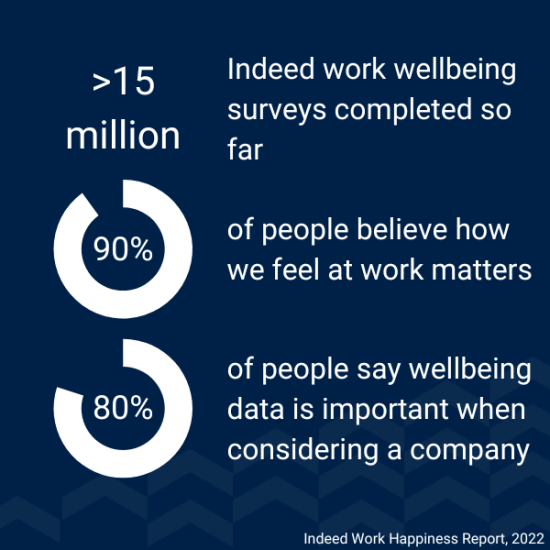A company which returns regularly impressive profits for its shareholders is good at ‘doing business’ when viewed through the traditional lens of wealth, but a non-profit which creates positive social impact – and values the wellbeing of its employees – is a morally ‘good’ organisation. Which is better? Our latest research demonstrates that the two needn’t be mutually exclusive.

Put simply, the happiest companies outperform their counterparts in all traditional measures of firm performance.
Investment in the top 100 US workplaces as ranked by employee wellbeing would have returned 20% more than the same investment in the S&P 500 or Dow Jones over the same two-year period.
This higher performance held true in both the so-called bull market of sustained growth through much of 2021 and the bear market of prolonged decline in 2022.
Clearly, there is a relationship between the subjective wellbeing of an organisation’s employees and its objective performance. Our work at the Wellbeing Research Centre seeks to examine why this is the case.
Measure what you treasure
Since 2019, we have been collaborating with jobs platform Indeed on the largest study of workplace wellbeing anywhere in the world.
Employees are encouraged to anonymously answer questions on what we consider the key measures of workplace wellbeing – job satisfaction, happiness, stress and purpose – as well as drivers thereof: such as manager support; compensation; inclusion; and belonging, among others.
The responses to these questions are used to inform a Work Wellbeing Score for each organisation, published for jobseekers and the world at large to see. To date, we have seen more than 17 million survey responses globally.
This huge amount of crowdsourced data allows us to identify trends across industries, geographic locations, and even within organisations. And, given that the questions are the same for everyone, we can rank companies to identify the Highest Wellbeing Places to Work.
It was by this measure that we created our own wellbeing stock portfolio at the start of 2021 – using data from the previous 12 months – and invested a hypothetical $1,000 into the best-performing 100 US companies.
Given that many of these are already listed companies, we also had access to publicly available data which enabled us to track the financial performance of each firm over time.
We re-balanced the portfolio at the start of 2022 and again at the start of this calendar year to reflect changes to the Highest Wellbeing Places to Work list.
And there it is: on average, a 20% greater return on investment compared to the S&P 500 or Dow Jones, and a whole lot more than the Nasdaq-100.

This analysis shows more clearly than ever that an investment in workplace wellbeing isn’t just the morally right thing to do, but the financially responsible approach, too.
And it’s encouraging to see ratings agencies and investment managers take note of our findings: S&P Global have already used our research as the justification for inclusion of wellbeing metrics in their large-scale Corporate Sustainability Assessment.
Taken alongside evidence which definitively shows the intuitive fact that happier companies retain staff longer, as well as attract greater talent, and the business case for workplace wellbeing is stronger than ever.
A matter of increasing importance
But we are also keen to understand the underlying cause of this positive relationship, given the opportunity to further increase workplace wellbeing.
To do this, we partnered with UK employer BT to study the individual-level impact of wellbeing at work on productivity.
We were given unprecedented access to BT’s network of call centres, based at multiple sites across the UK, and anonymised performance data for employees which included sales figures and customer satisfaction scores.
We sent employees a one-question pulse survey at the same time every week, asking them to assess their wellbeing on a scale of one to five.
Collating responses with individuals’ performance data enabled us to produce the first causal field evidence for the relationship between workplace wellbeing and productivity: namely, on average, a 12% increase in productivity per one-point increase on our happiness scale.
But what was most revealing was the scale of the boost to productivity dependent on the task at hand. Basic tasks – for example, simply taking a customer’s details – showed a smaller increase than for those duties which required greater social and emotional intelligence.

Happier workers completing more complex tasks, such as upselling package deals or retaining customers, showed a boost to productivity closer to 20%.
And, as artificial intelligence enables greater automation of the most basic of tasks – and with social and emotional skills taking on a yet larger role in our future workplaces – the importance of workplace wellbeing is only likely to get bigger over time.
Learn more about the work of the Wellbeing Research Centre.
Related podcast
Listen to Jan-Emmanuel speak to University of Oxford Vice-Chancellor Irene Tracey about wellbeing in the workplace in her podcast, Fire & Wire.



